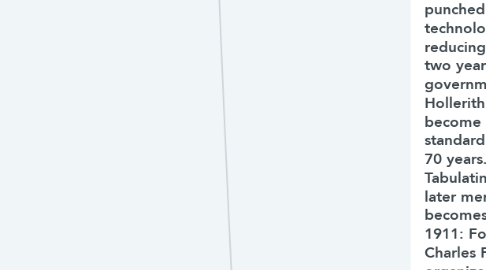The history of IBM - 100+ Years of Innovation
by Deependra Mandrawal

1. 1880s–1937
2. Image not available The history of IBM - 100+ Years of Innovation Image not available 1880s–1937 1890: Punched cards The U.S. Census Bureau contracts to use Herman Hollerith's punched card tabulating technology on the 1890 census, reducing a 10-year process to two years and saving the government $5 million. Hollerith's punched cards become the tabulating industry standard for input for the next 70 years. Hollerith's Tabulating Machine Company is later merged into what becomes IBM. 1911: Formation Charles Flint, a noted trust organizer, engineers the merger of four companies: Tabulating Machine Company International Time Recording Company Computing Scale Corporation Bundy Manufacturing Company The combined Computing- Tabulating- Recording Company (C-T-R) manufactures and sells machinery ranging from commercial scales and industrial time recorders to meat and cheese slicers, along with tabulators and punched cards. Based in New York City, the new company had 1,300 employees and offices and plants in Endicott and Binghamton, New York; Dayton, Ohio; Detroit, Michigan; Washington, D.C.; and Toronto, Ontario. 1914: Watson arrives Thomas J. Watson Sr. assumes the General Manager position for C-T-R. Less than a year later he becomes President of the firm. 1914: First disabled employee IBM hires its first disabled employee. 1915: "THINK" signs IBM's ubiquitous "THINK" signs, based on the slogan coined by Thomas J. Watson, Sr., and are used in the company for the first time. 1916: Employee education IBM invests in its employees and creates an education program. Over the next two decades the program would expand to include management education, volunteer study clubs, and the construction of the IBM Schoolhouse in 1933 1923: IBM Germany IBM acquires majority ownership of the German tabulating firm Deutsche Hollerith Maschinen Groupe 1924: International Business Machines Corporation On February 14, 1924, C-T-R's name was formally changed to International Business Machines Corporation (IBM), to more accurately reflect the company's aspirations and mission. The name was first used by the company's Canadian subsidiary in 1917. 1927: IBM Italy IBM opens its first office in Italy in Milan, and starts selling and operating with National Insurance and Banks. 1933: 40-hour week IBM introduces the 40-hour week for both manufacturing and office locations. 1934 – Group life insurance IBM creates a group life insurance plan for all employees with at least one year of service. 1934: Elimination of piece-work Watson, Sr., places IBM's factory employees on salary, eliminating piece-work and providing employees and their families with an added degree of economic stability 1934: Scientific computing IBM partners with Columbia University to create the world's first tabulating machine data center dedicated to scientific research The lab would be later named the Thomas J. Watson Astronomical Computing Bureau. 1934: IBM 801 The IBM 801 Bank Proof machine to clear bank checks is introduced A new type of proof machine, the 801 lists and separates checks, endorses them, and records totals It dramatically improves the efficiency of the check clearing process 1935: Social Security Administration During the Great Depression, IBM keeps its factories producing new machines even while demand is slack When Congress passes the Social Security Act in 1935, IBM – with its overstocked inventory – is consequently positioned to win the landmark government contract, which is called "the biggest accounting operation of all time 1937: IBM 805 test scoring machine IBM's Rey Johnson designs the IBM 805 to greatly speed the process of test scoring The 805's innovative pencil-mark sensing technology gives rise to the ubiquitous phrase, “Please completely fill in the oval.” 1937: Berlin conference As president of the International Chamber of Commerce, Watson Sr., presides over the ICC's 9th Congress in Berlin While there he accepts a Merit Cross of the German Eagle with Star medal from the Nazi government honoring his activities on behalf of world peace and international trade He later returned it Image not available 1938–1951 Image not available 1952–1963 Image not available 1964–1971 Image not available 1972–1992 Image not available 1993–present a


